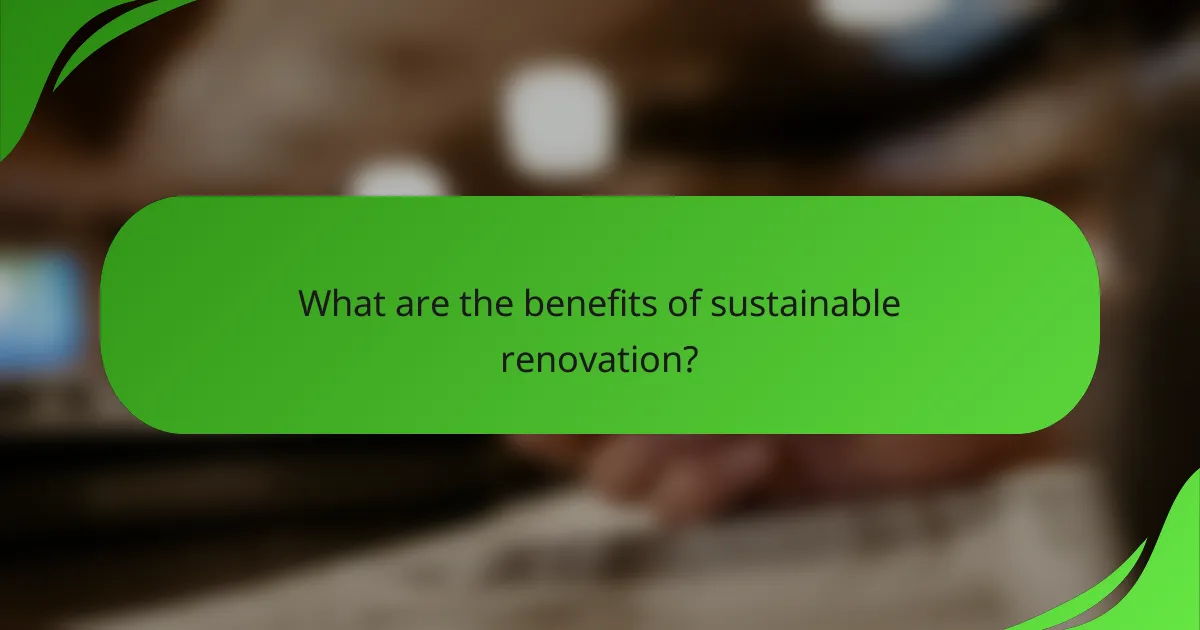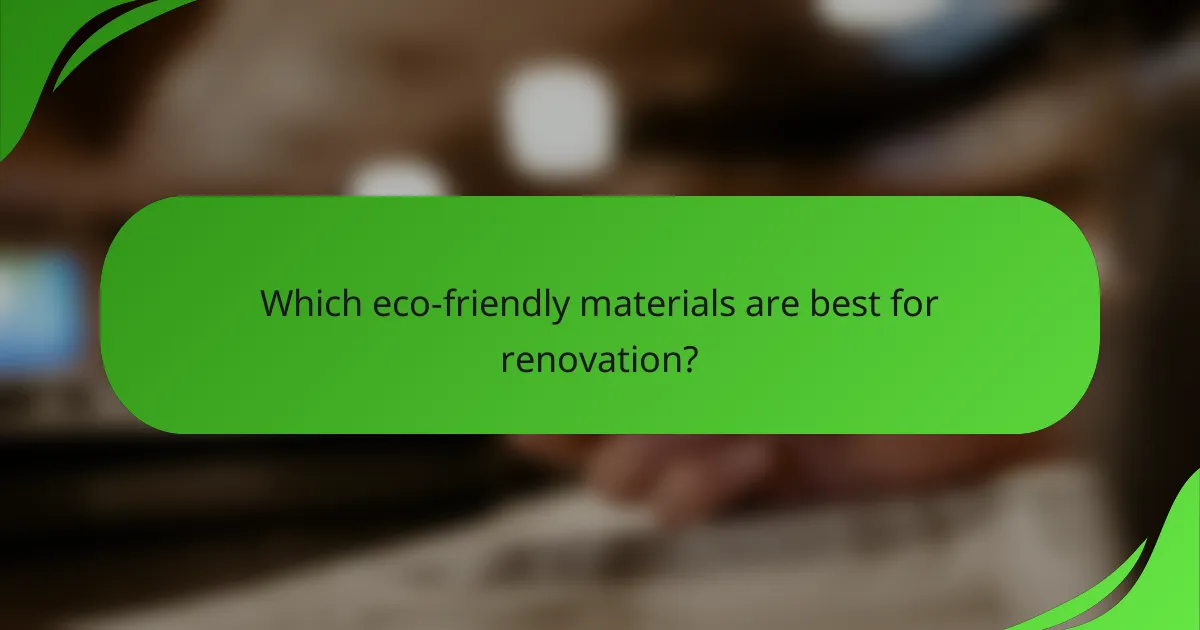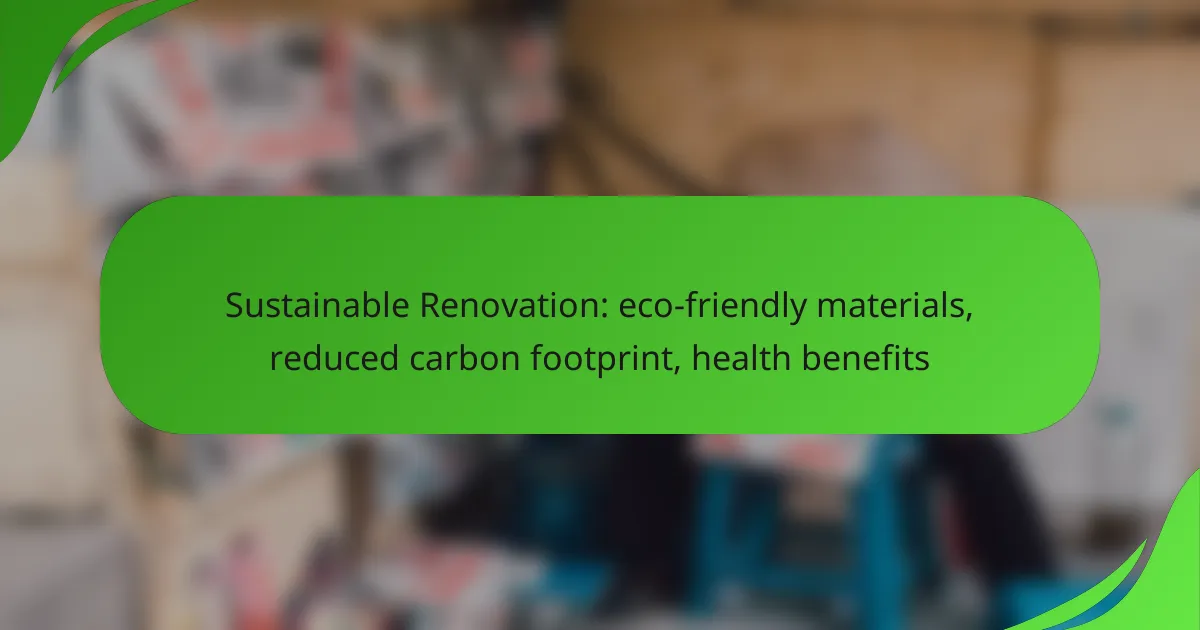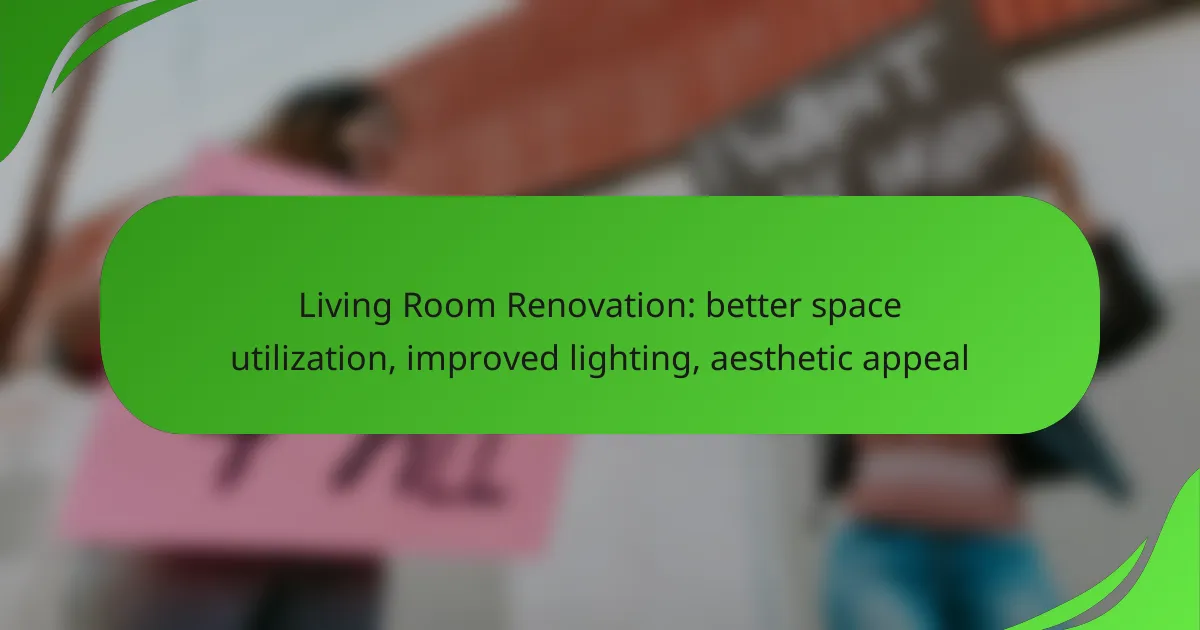Sustainable renovation is an innovative approach that combines environmental responsibility with home improvement, offering significant benefits for both the planet and personal well-being. By using eco-friendly materials and energy-efficient technologies, homeowners can reduce their carbon footprint, lower energy consumption, and create healthier living environments. Embracing sustainable practices not only enhances the aesthetic appeal of a home but also contributes to a more sustainable future.

What are the benefits of sustainable renovation?
Sustainable renovation offers numerous advantages, including environmental, economic, and health benefits. By utilizing eco-friendly materials and practices, homeowners can significantly reduce their carbon footprint while enhancing their living spaces.
Reduced carbon footprint
One of the primary benefits of sustainable renovation is the reduction of the carbon footprint associated with construction and home improvement. This can be achieved by using materials with lower embodied energy, such as recycled or locally sourced products.
Consider implementing energy-efficient systems, like solar panels or high-efficiency HVAC units, which can further minimize greenhouse gas emissions. The goal is to create a home that operates sustainably, contributing to a healthier planet.
Improved indoor air quality
Sustainable renovation often leads to improved indoor air quality, which is crucial for occupant health. By choosing non-toxic paints, finishes, and materials, you can reduce the presence of harmful volatile organic compounds (VOCs) in your home.
Incorporating proper ventilation systems and using natural materials can help maintain fresh air circulation, further enhancing the indoor environment. This is particularly important in urban areas where outdoor air quality may be compromised.
Enhanced property value
Homes that are renovated sustainably often see an increase in property value. Buyers are increasingly looking for energy-efficient and eco-friendly features, making these homes more attractive in the real estate market.
Investing in sustainable renovations can yield a return on investment, as properties with green certifications or energy-efficient upgrades tend to sell for higher prices compared to traditional homes.
Lower energy costs
Sustainable renovations can lead to significant reductions in energy costs over time. By upgrading insulation, windows, and appliances to energy-efficient models, homeowners can lower their monthly utility bills.
In many cases, the initial investment in energy-efficient upgrades is offset by long-term savings, making it a financially sound decision. Additionally, many regions offer incentives or rebates for energy-efficient renovations, further reducing upfront costs.
Health benefits for occupants
Renovating sustainably can provide various health benefits for occupants. Improved indoor air quality and the use of non-toxic materials contribute to a healthier living environment, reducing the risk of respiratory issues and allergies.
Moreover, sustainable homes often incorporate natural lighting and outdoor spaces, which can enhance mental well-being and overall quality of life. Creating a healthy home environment is a key aspect of sustainable renovation.

Which eco-friendly materials are best for renovation?
Eco-friendly materials for renovation prioritize sustainability, health, and reduced environmental impact. Key options include recycled materials, bamboo flooring, low-VOC paints, and insulation made from recycled denim.
Recycled materials
Recycled materials are an excellent choice for sustainable renovations, as they reduce waste and conserve resources. Common options include reclaimed wood, recycled metal, and repurposed glass, which can be used in various applications from flooring to countertops.
When selecting recycled materials, check for certifications that ensure quality and sustainability. Look for products that are locally sourced to minimize transportation emissions and support local economies.
Bamboo flooring
Bamboo flooring is a popular eco-friendly alternative to traditional hardwood, as it grows rapidly and can be harvested sustainably. It offers durability and a unique aesthetic, making it suitable for various design styles.
When choosing bamboo flooring, opt for products that are certified by organizations like the Forest Stewardship Council (FSC) to ensure responsible sourcing. Consider the finish as well; some finishes may contain harmful chemicals, so look for low-VOC options.
Low-VOC paints
Low-VOC (volatile organic compounds) paints are essential for maintaining indoor air quality during renovations. These paints emit fewer harmful chemicals, making them safer for both occupants and the environment.
When selecting low-VOC paints, check the label for VOC content, aiming for products with less than 50 grams per liter. This ensures a healthier living space while still providing a wide range of colors and finishes.
Insulation made from recycled denim
Insulation made from recycled denim is an innovative and eco-friendly option that provides excellent thermal performance. This type of insulation is made from post-consumer denim, diverting waste from landfills while improving energy efficiency in homes.
When considering denim insulation, look for products that are treated with non-toxic fire retardants and are free from harmful chemicals. This ensures a safe installation process and contributes to a healthier indoor environment.

How can sustainable renovation reduce energy consumption?
Sustainable renovation can significantly lower energy consumption by incorporating energy-efficient materials and technologies. By optimizing the building envelope and utilizing renewable energy sources, homeowners can reduce their reliance on fossil fuels and lower utility bills.
Energy-efficient windows
Energy-efficient windows are designed to minimize heat loss and gain, which helps maintain a comfortable indoor temperature. These windows often feature multiple panes, low-emissivity coatings, and insulating frames. Upgrading to such windows can reduce heating and cooling costs by up to 30% compared to standard windows.
When selecting energy-efficient windows, look for those with a high Energy Star rating and consider the climate in your area. In colder regions, double or triple glazing may be more beneficial, while warmer climates might prioritize low solar heat gain coefficients.
Solar panels
Solar panels convert sunlight into electricity, providing a renewable energy source that can drastically cut energy bills. By installing solar panels, homeowners can generate their own electricity, reducing dependence on grid power and lowering carbon emissions. Many regions offer incentives or rebates that can offset installation costs.
When considering solar panels, evaluate your roof’s orientation and shading, as these factors influence energy production. A typical residential solar system can cover a significant portion of energy needs, often leading to savings of hundreds of dollars annually.
Smart home technology
Smart home technology enhances energy efficiency by allowing homeowners to monitor and control their energy use in real-time. Devices such as smart thermostats, lighting systems, and energy monitors can optimize energy consumption based on occupancy and usage patterns.
To maximize the benefits of smart home technology, invest in devices that integrate seamlessly with your existing systems. Consider setting schedules for heating and cooling or using motion sensors to ensure lights are only on when needed. This can lead to energy savings of 10-20% over time.

What are the costs associated with sustainable renovation?
The costs associated with sustainable renovation can vary significantly based on the materials used and the scope of the project. While the initial investment may be higher, the long-term savings and health benefits often justify the expense.
Initial investment vs. long-term savings
Sustainable renovations typically require a higher upfront investment due to eco-friendly materials and energy-efficient systems. However, these costs can be offset by long-term savings on utility bills, maintenance, and potential increases in property value.
For example, energy-efficient windows may cost more initially but can reduce heating and cooling costs by a significant percentage over time. Homeowners should consider the payback period for these investments, which can range from a few years to over a decade depending on the improvements made.
Cost of eco-friendly materials
The cost of eco-friendly materials can vary widely based on the type and source. Materials such as reclaimed wood, bamboo, or recycled metal may have higher prices compared to conventional options, but they often provide durability and aesthetic appeal.
Homeowners should research local suppliers for sustainable materials, as prices can differ based on availability and regional demand. Budgeting for these materials should include not only the purchase price but also any potential installation costs, which may be higher for specialized products.








